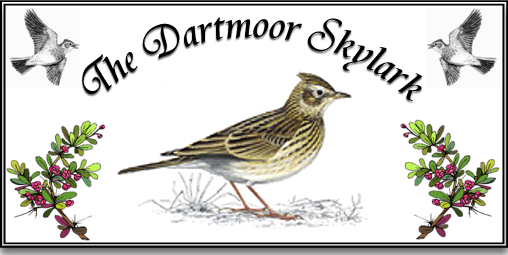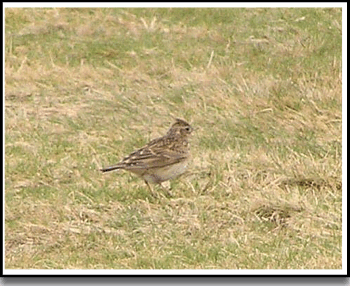
Sonnet to the Lark on Dartmoor
Sweet soaring minstrel of the wild, I hear
The pleasing music of thy tuneful throat,
As welcome o’er the desert to mine ear,
As to benighted hinds the matin note.
I thank thee, warbler, for thy cheering lay,
But why in such a barren lonely dell;
While other scenes the vernal sweet display,
A wing’d recluse art thou content to dwell ?
O, yet I trace the motives in thy song,
For freedom now the lofty burthen bears,
And now a tenderer starin is pour’d along,
And love is breath’d with all its charming cares:
Thus, though e’en here sequester’d dost thou prove
Life’s dearest blessings, Liberty and Love.
Mr Emmet – 1793.
There is nothing more evocative of summer than to walk amongst the heather and hear the melodic trilling of a Skylark high in the heavens. These little birds are the masters of camouflage and very often you can be walking amongst the tussocks when there is a sudden explosion of feathers and an unseen skylark plummets skywards amidst a crescendo of song.
Contrary to the national picture, the Dartmoor Skylark population is in a stable and healthy condition. It is estimated that across Britain the breeding population has declined by a much as 54% on farm lowlands between 1969 and 1991. Current thinking is that the decline is due to farming methods and loss of natural habitat in the lowland areas. In 1979 as survey revealed that the numbers on Dartmoor were on the whole very good with an estimated total population of around 15,000 pairs. The density of Skylarks on the moor was said to be a lot higher than other upland regions of the country and was placed at 32.8 pairs per square kilometre. These figures make the Skylark the second most numerous breeding bird on Dartmoor, the Meadow Pipit being the highest.
The Skylark or Alauda arvensis to give it its Latin name is a small, mottled brown bird with a noticeable crest on its head which is raised when the bird is excited or alarmed. During the summer Skylarks tend to favour areas of long grass, heather, or blanket bog where they can feed on a diet of invertebrates, shoots, and seeds. They nest on the ground and breed from April to early August when usually between 1 and 4 clutches of eggs will be laid, these clutches normally consist of anything from 3 to 5, greyish white spotted eggs. The nests are very well camouflaged in the long grass and it can be very easy to step on one without realising it. Very often you will see a Skylark alight from the ground where it is easy enough to think it has been disturbed from its nest. But in fact what they will do is run a few yards away from the nest before taking off, by doing this they draw attention away from the eggs or chicks. Sometimes you will see a Skylark fluttering along the ground giving the appearance of being injured, again this is to draw attention away from their nest. When the bird considers it has led the danger far enough away it will suddenly take off and soar up into the air.
Both parents will feed the chicks and for the first week the diet will consist of purely insects and then gradual amounts of seeds and shoot will be introduced to finally provide a fully mixed diet.

By late August the Skylarks leave the moor where it is thought they move onto nearby lowland farmland where they feed off the stubbles and fields. Here they will over-winter until the following March before once again returning to the high moors.
The skylark can be a good weather forecaster for it is said that in a period of unsettled fine weather the skylark descends slowly, hovering and gliding down to earth, however If rain is imminent it will drop like a stone.
The Skylark.
The rolls and harrows lie at rest beside
The battered road; and spreading far and wide
Above the russet clods, the corn is seen
Sprouting its spiry points of tender green,
Where squats the hare, to terrors wide awake,
Like some brown clod the harrows failed to break.
Opening their golden caskets to the sun,
The buttercups make schoolboys eager run,
To see who shall be first to pluck the prize –
Up from their hurry, see, the skylark flies,
And o’er her half-formed nest, with happy wings
Winnows the air, till in the cloud she sings,
Then hangs a dust-spot in the sunny skies,
And drops, and drops, till in her nest she lies,
Which they unheeded passed – not dreaming then
That birds which flew so high would drop agen
To nests upon the ground, which anything
May come at to destroy. Had they the wing
Like such a bird, themselves would be too proud,
And build on nothing but a passing cloud!
As free from danger as the heavens are free
From pain and toil, there would they build and be,
And sail about the world to scenes unheard
Of and unseen – Oh, were they but a bird!
So think they, while they listen to its song,
And smile and fancy and so pass along;
While its low nest, moist with the dews of morn,
Lies safely, with the leveret, in the corn.
John Clare 1793 -1864
 Legendary Dartmoor The many aspects past and present of Dartmoor
Legendary Dartmoor The many aspects past and present of Dartmoor

There is nothing like the background sound of these birds, when they return to Dartmoor in the spring…
My dad always used to say if you pointed at a skylark you’d end up with a whitlow on your finger, and proceeded to try to trick me into pointing at them whenever we were walking on the moor. I can’t find any reference to this superstition anywhere else but it seems like an odd thing to make up? Anyone else heard this?